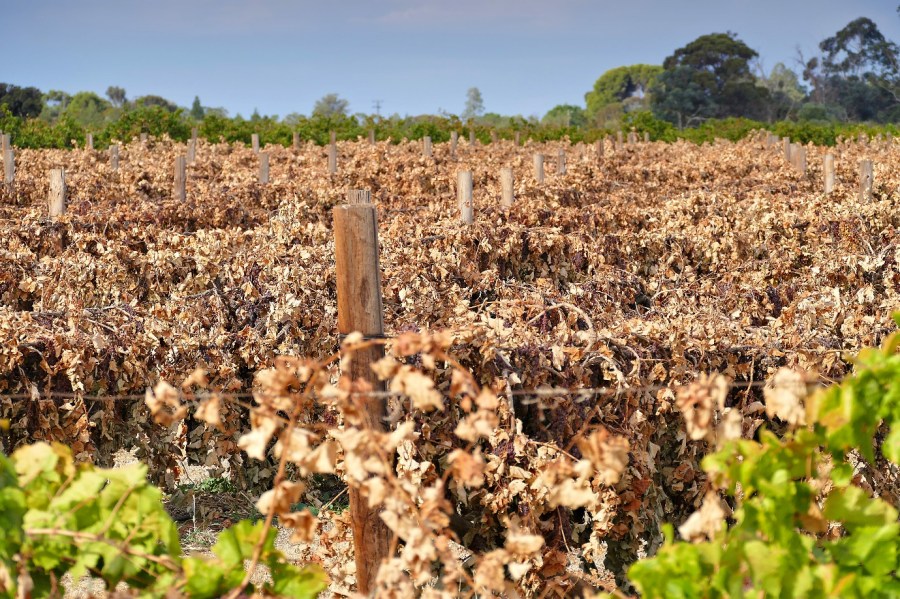The certainty of uncertain weather trends
Volatile weather patterns have devastated vineyards across France and Germany recently, causing unexpected havoc and huge losses to wine producers. The impact of climatic shifts on grape cultivation is undeniable, with devastating hailstorms, like those that pummelled north Burgundy and Chablis, and sudden cold snaps with accompanying frosts in Germany, meaning decimated vineyards struggle to recover – and some producers face the grim prospect of losing entire crops.
Even regions traditionally spared from such extremes, like the UK, are not immune, as evidenced by the crippling frosts of May 2020 that slashed yields and threatened market growth in a growing industry.
This year, in Germany, vines were significantly ahead of their usual growth due to an unusually warm spring, but temperatures plummeted as low as -5°C towards the end of April, destroying much of the 2024 crop, with some areas experiencing upwards of 70% damage.
Despite attempts to mitigate the freeze with candles, the unexpected and widespread frosts left vineyards vulnerable, particularly in regions like Nahe and Baden.
In France, particularly in Cahors and the regions of Jura, Bugey, Savoie and Provence, significant losses resulted from similar frosts, with reports indicating up to 90% crop loss in Cahors – a devastating torment – and heavy damage in other areas like Luberon, and certain parts of Alsace and Burgundy.
Grappling with the consequences
The consequences of these climatic upheavals of course extend far beyond the vineyards themselves, rippling through the entire wine production chain – from grape to bottle. Devastating losses to vineyards that can happen so suddenly – overnight, in most cases – set in motion a domino effect that not only this season’s crop will suffer from.
As such, the imperative for proactive risk management is starkly evident. If frost, hail and other perils are to continue threatening livelihoods for an industry with a rich and enduring heritage, the case for comprehensive insurance coverage grows ever stronger.
So, how can wine makers safeguard their livelihoods in the face of escalating climate risks?
The answer may be in a novel insurance solution designed to mitigate the impact of weather-related perils on vineyards and give owners greater control over the vagaries of Mother Nature.
Uncorking an innovative solution
Traditionally, insurance coverage for vineyards has fallen short, failing to address the nuanced risks posed by climatic variability. What growers need, say experts, is a bespoke insurance offering tailored to the unique needs of each vineyard in every growing season.
Coverage against frost during the critical four-to-six week blooming season in April – to shield vineyards from the devastating impact of temperature fluctuations – is crucial. By leveraging index-based triggers tied to temperature thresholds, the ideal policy would ensure swift payouts when conditions meet predefined criteria – a fruitful way to offer financial certainty and resilience.
How would a policy like this work?
Yield protection coverage would involve an index cover set to the client-selected risk period and structured to pay out if temperatures drop below predefined thresholds. Before the cover starts, existing stations in the field vicinity or weather stations installed at agreed locations onsite would monitor local temperatures and set up a regulation system for an insurance payout grid.
Once cover starts, temperatures would then be monitored on a daily basis. If the temperature drops to a certain level, vineyard clients would receive a pre-determined percentage of the limit. If the temperature lowers even further, growers may find themselves receiving 100% of the limit. The client could also have shared access to all data, to use as a useful prevention tool – to anticipate frosts or other adverse conditions and prepare for them effectively.
The benefits of such a policy would extend beyond mere financial protection, too. If weather stations could provide real-time data access and a streamlined claims processing service, there would be no need for costly on-site assessments. Such a solution would enable vineyard owners to be reassured their vines are safeguarded against all climatic uncertainties without having to deal with undue administrative burden.
Disease mitigation could also be factored in. Vineyard owners could tailor their coverage to address their specific vulnerabilities, ensuring the continuity of their operations in the face of adversity.
As the wine industry grapples with the mounting threat of climate change, the need for proactive risk management has never been more pressing. Parametric insurance solutions, like the one described, offer a pathway to resilience, empowering vineyard owners to protect their crops and preserve their livelihoods in a worrying climate of erratic weather. And innovative solutions for the wine industry can only foster stability and continuity across its entire supply chain, safeguarding the fruits of labour for generations to come.
As the wine industry evolves, so too must its approach to risk management, ensuring a resilient and sustainable future for vineyards around the globe, whatever the weather.
Ascend Vineyard Protect has comprehensive and competitive insurance programmes specifically designed for the growing UK wine industry.
Specialist insurance broker to the wine industry Ascend Broking, provide an insight to climate insurance solutions to the vineyard and wine production industry through www.vineyardprotect.co.uk and www.winesandspiritsprotect.co.uk provide an insight into the solutions that are available.





